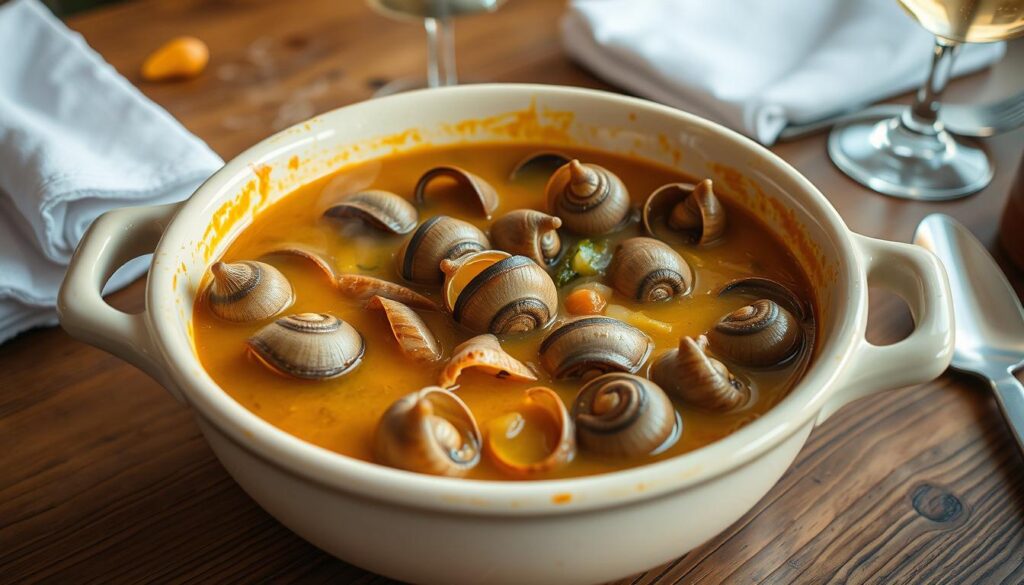We explore the rich culinary tradition behind escargot soup, a dish that embodies the elegance of French cuisine. For centuries, snails have been a staple in French cooking, appreciated for their unique taste and nutritional value.
By breaking down the recipe into manageable steps, we aim to demystify this seemingly complex dish, making it accessible to any home cook. The key to a great soup lies in balancing rich flavors with a light texture, a quality that makes it perfect for special occasions or dinner parties.
Understanding the basic ingredients and their roles in the dish is crucial. Canned snails, or escargot, are fully cooked and come with their flavorful cooking juices, simplifying the preparation process.
The Culinary Heritage of Escargot Soup
With its origins dating back to Roman times, escargot soup has evolved into a sophisticated French dish. The tradition of consuming escargot dates back to the Renaissance, where it became a delicacy, particularly in the Burgundy region.
The Significance of Escargot in French Cuisine
Escargot is more than just a dish; it represents a connection to the land and a celebration of France’s agricultural heritage. The French tradition of consuming escargot has been influenced by various regions, each contributing its unique twist to the recipe. Snails are typically prepared with garlic, butter, and herbs, creating a flavorful broth that is both rich and aromatic.
Regional Twists on Escargot Soup
Regional variations of escargot soup showcase the diversity of French cuisine. For instance, the Champagne region offers a version that incorporates wine, creating a light yet flavorful broth. In contrast, Provence is known for its hearty, garlic-infused preparations. The table below highlights some regional variations:
| Region | Characteristic Ingredient | Broth Style |
|---|---|---|
| Burgundy | Garlic, Butter | Rich, Creamy |
| Champagne | Sparkling Wine | Light, Flavorful |
| Provence | Garlic, Herbs | Hearty, Aromatic |
The variations in escargot soup not only reflect regional preferences but also demonstrate the versatility of this classic recipe. Whether it’s served as an appetizer or a main course, escargot soup remains a beloved dish throughout France and beyond.
Essential Ingredients for Authentic Escargot Soup
Creating an authentic escargot soup requires careful selection of ingredients, a process that lays the foundation for a rich and flavorful dish. The quality of the ingredients directly impacts the overall taste and character of the soup.
Selecting and Preparing Escargot
The foundation of exceptional escargot soup begins with properly selecting and preparing the snails themselves. Most home cooks opt for high-quality canned escargot that comes pre-cooked and ready to incorporate into the soup. We recommend using Helix pomatia (Burgundy snails) whenever possible, as their meaty texture and subtle flavor make them ideal.
Mushroom and Aromatics Selection
The aromatic base of escargot soup typically includes shallots, garlic, and carefully selected mushrooms that complement rather than overpower the delicate flavor of the escargot. Oyster and shiitake mushrooms offer excellent options for their subtle earthiness.
The Importance of Quality Stock and Wine
Quality stock forms the backbone of the soup, with chicken stock being traditional, though vegetable stock can serve as an excellent alternative. The choice of wine significantly impacts the final character of the soup, with dry white wines or champagne adding brightness and acidity that balances the richness of the butter and cream components.
- Use high-quality canned escargot for convenience and consistency.
- Choose flavorful mushrooms like oyster and shiitake for their earthy undertones.
- Opt for chicken or vegetable stock as the base of the soup.
- Select a dry white wine or champagne to add depth to the soup.
Step-by-Step Escargot Soup Preparation
Creating the perfect escargot soup involves several steps, each crucial to the final dish. We guide you through the process, ensuring a delicious and authentic French culinary experience.
Creating the Flavor Base
To start, we sauté finely chopped shallots in a combination of butter and olive oil until they’re translucent but not browned, which takes about 2-3 minutes over medium heat. This step is crucial for developing the soup’s depth of flavor.
Preparing the Escargot
The escargot requires careful preparation to maintain its delicate texture. Sauté the snails in butter for about 4 minutes until they’re lightly golden, then remove and set aside.

Combining and Simmering the Soup
Next, we add mushrooms to the shallot mixture and cook gently over low heat for approximately 5 minutes. We then incorporate wine, allowing it to reduce, followed by stock, and simmer the soup gently for about 15 minutes.
Finishing Touches for Perfect Texture
To finish, we stir in cream and simmer for an additional 3-5 minutes until the soup reaches the desired consistency. We then return the reserved escargot to the soup, seasoning carefully with salt and pepper to taste.
- Use high-quality ingredients for the best flavor.
- Don’t overcook the escargot to maintain its tender texture.
- Adjust seasoning according to taste, considering the salt content in canned escargot.
Serving and Enjoying Your Escargot Soup
The art of serving Escargot Soup is just as crucial as its preparation, requiring attention to detail and a touch of elegance. We recommend serving it in shallow, warmed bowls to showcase the beautiful cream-based broth and its delicate ingredients.
To enhance the experience, consider pairing it with toasted country bread brushed with garlic butter and a crisp white Burgundy. Garnish with finely chopped parsley for added freshness. The temperature is crucial; serve hot, but not scalding, to allow the aromatic elements to shine.


